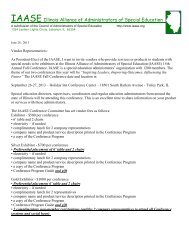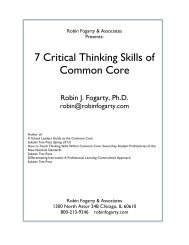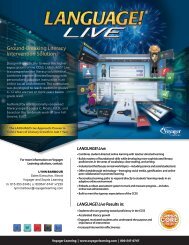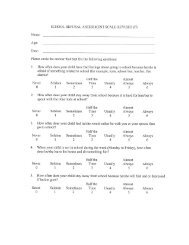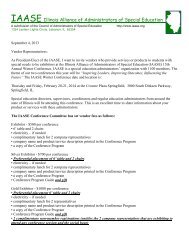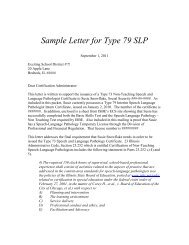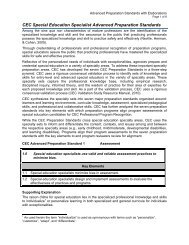Illinois Special Education Eligibility and Entitlement ... - IAASE
Illinois Special Education Eligibility and Entitlement ... - IAASE
Illinois Special Education Eligibility and Entitlement ... - IAASE
You also want an ePaper? Increase the reach of your titles
YUMPU automatically turns print PDFs into web optimized ePapers that Google loves.
ELLs who grow up in the U.S. are often considered simultaneous bilinguals whose full language skills<br />
would be a composite of both the first <strong>and</strong> second language. Examining concept knowledge <strong>and</strong><br />
vocabulary in only one language does not accurately reflect their full language proficiencies.<br />
Mixed proficiency in the native language <strong>and</strong> in English is not an indicator of language impairment.<br />
A student may demonstrate strengths <strong>and</strong> weaknesses in either or both languages depending on<br />
instruction <strong>and</strong> usage of first language <strong>and</strong> second language at home <strong>and</strong> school.<br />
When an underlying difficulty is due to a disability, it will manifest itself across languages <strong>and</strong><br />
contexts. For example, if the child is having difficulty following directions, then the team should see<br />
if the same difficulty occurs in social as well as academic settings <strong>and</strong> occurs in the home language<br />
as well as in English. It would not be appropriate to find an ELL to have a disability in one language<br />
<strong>and</strong> not the other.<br />
B. Additional Procedures for Determining the Existence of a Specific Learning Disability<br />
1. Adequate Achievement<br />
…In determining whether an ELL is achieving adequately for his or her age or to meet state-approved<br />
grade level st<strong>and</strong>ards, the considerations <strong>and</strong> cautions discussed in previous sections of this document<br />
are applicable to the IEP team’s decision making process. For example, if an ELL’s performance is<br />
compared to a peer group in order to determine adequate progress, that group should consist of the<br />
student’s like peers (as described previously). Also, the st<strong>and</strong>ards to which the student’s performance is<br />
compared may need to include both the ELP st<strong>and</strong>ards as well as grade level content st<strong>and</strong>ards adopted<br />
by the state of <strong>Illinois</strong>.<br />
2. Exclusionary Criteria<br />
d. Cultural factors<br />
…Further, sensitivity <strong>and</strong> instruction/curriculum review are needed to assess if instruction is<br />
“culturally responsive,” which is an important element of appropriate instruction. Students may<br />
also display academic deficiencies that are related to their acculturation experience in the U.S.<br />
<strong>and</strong> these must be considered. Partnering with parents is crucial in assessing whether cultural<br />
factors are the primary reason for the student’s difficulties, as are student interviews <strong>and</strong><br />
observation.<br />
f. Limited English Proficiency<br />
…The same factors <strong>and</strong> considerations for ELLs discussed under ruling out LEP in Subsection A<br />
(Determinant Factors – All Disabilities, see Item 2) of this section are applicable here.<br />
3. Appropriate Instruction <strong>and</strong> Repeated Assessments<br />
a. Data demonstrating the student was provided appropriate instruction from qualified personnel:<br />
…For ELLs, instruction should follow best practice based on research specific to the ELL<br />
population. Further, personnel providing instruction should not only include individuals who are<br />
qualified in their subject matter but also those who are qualified in the instruction of ELLs.<br />
<br />
In the context of the ELL population, the effectiveness of the intervention(s) with similar<br />
ELLs is supported by peer-reviewed research. In the absence of such research, districts may<br />
use state, regional, or locally-obtained ELL data.<br />
<strong>Illinois</strong> State Board of <strong>Education</strong> 4 September 11, 2012



